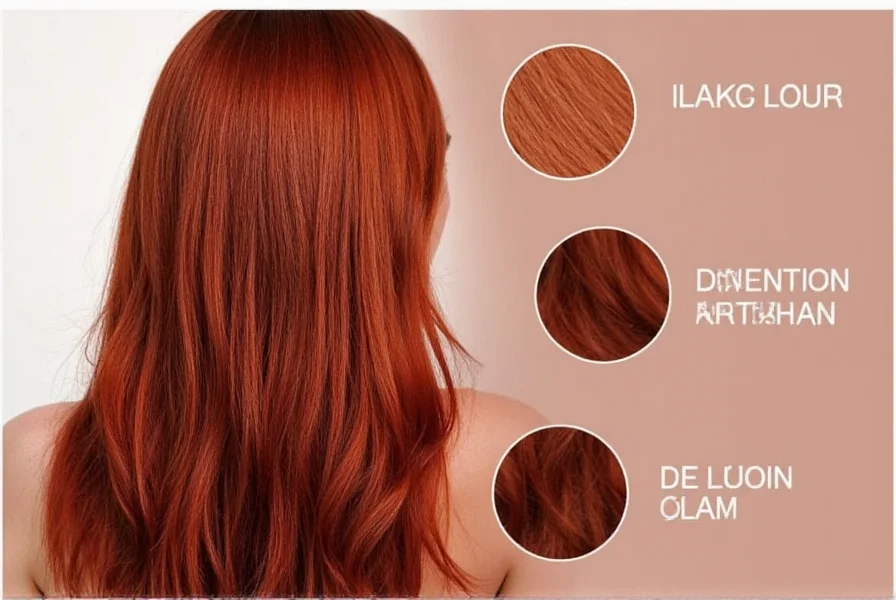Dark ginger hair color is a rich, deep reddish-brown shade with warm copper undertones that sits between traditional ginger and auburn on the color spectrum. Unlike brighter ginger shades, dark ginger contains more brown pigment, creating a sophisticated, natural-looking red that complements a wide range of skin tones while maintaining red hair's distinctive warmth. This versatile shade typically falls between level 4-6 on the hair color chart (dark brown to medium brown) with red and copper undertones.
For those considering a vibrant yet subtle transformation, dark ginger hair color offers the perfect balance between boldness and wearability. This sophisticated shade has surged in popularity as celebrities and influencers embrace richer red variations that feel modern and low-maintenance compared to brighter reds. Understanding the nuances of dark ginger versus similar shades like auburn or copper is essential for achieving your desired look.
Understanding Dark Ginger: More Than Just Red Hair
Dark ginger occupies a unique space in the red hair spectrum. While traditional ginger tends toward bright orange-red tones, dark ginger incorporates significantly more brown base, creating depth and dimension. This hair color variation maintains red hair's characteristic warmth while appearing more natural and less high-maintenance than brighter red shades.
The magic of dark ginger lies in its undertones. Unlike auburn (which leans more toward burgundy) or copper (which emphasizes golden tones), dark ginger balances copper and red pigments over a brown base. This creates a multidimensional effect that changes subtly in different lighting conditions—appearing richer indoors and revealing warm copper flashes in sunlight.
Dark Ginger Hair Color Chart: Understanding the Spectrum
Professional colorists use a standardized numbering system to describe hair color levels and tones. Dark ginger typically falls within these parameters:
| Hair Color Level | Description | Dark Ginger Application |
|---|---|---|
| Level 4 (Dark Brown) | Deep brown base | Base for deepest dark ginger variations |
| Level 5 (Medium Brown) | Balanced brown | Most common base for true dark ginger |
| Level 6 (Light Brown) | Warm brown | Base for brighter dark ginger variations |
| IR (Intense Red) | Red pigment | Primary tone modifier for dark ginger |
| C (Copper) | Copper pigment | Secondary tone for dimension |
Skin Tone Compatibility: Who Looks Best with Dark Ginger?
One reason dark ginger has gained popularity is its remarkable versatility across skin tones. Unlike brighter reds that can overwhelm certain complexions, dark ginger's brown base makes it surprisingly adaptable:
- Fair skin with cool undertones: Creates a striking contrast that enhances blue or green eyes while avoiding the "washed out" effect some bright reds cause
- Medium skin tones: Complements golden and olive undertones beautifully, with dark ginger acting as a natural extension of warm complexions
- Deeper skin tones: Provides rich dimension that enhances natural warmth without competing with deeper complexions
The key to successful dark ginger application lies in adjusting the copper-to-red ratio based on your specific undertones. Those with cool undertones should opt for dark ginger with slightly more red pigment, while warm undertones shine with versions emphasizing copper tones.
Achieving Professional-Quality Dark Ginger at Home
If you're considering DIY dark ginger coloring, understanding formulation is crucial. Professional dark ginger typically combines:
- A base color in the 4-6 range (dark to light brown)
- Red pigment (typically 20-40% depending on desired intensity)
- Copper modifier (10-20% for dimension)
- Appropriate developer volume (10-20 volume for minimal lift)
For brunettes transitioning to dark ginger, minimal lightening is usually required, making it one of the most accessible red variations for darker-haired individuals. Those with lighter bases should consider a pre-color glaze to neutralize unwanted brassiness.
Maintenance Essentials for Long-Lasting Dark Ginger
While dark ginger requires less frequent touch-ups than brighter reds, proper maintenance preserves its richness. Implement these practices:
- Sulfate-free shampoo: Prevents premature fading of red pigments
- Cool water rinses: Helps seal cuticles and retain color
- Color-depositing conditioners: Use weekly to refresh copper tones
- UV protection: Apply leave-in treatments with UV filters before sun exposure
- Strategic toning: Every 4-6 weeks, use a violet-based toner to counteract brassiness
Dark ginger typically maintains its vibrancy for 6-8 weeks before noticeable fading occurs—significantly longer than brighter red shades. When touch-ups are needed, focus on regrowth areas rather than reapplying color to the entire length, which can lead to over-accumulation of red pigment.
Dark Ginger Variations: Finding Your Perfect Shade
Not all dark ginger is created equal. Understanding these subtle variations helps you select the ideal shade:
- True dark ginger: Equal parts red and copper over a medium brown base (level 5)
- Deep copper-ginger: More copper than red, creating a warmer, autumnal effect
- Red-brown ginger: Higher brown content with subtle red undertones for a natural look
- Chocolate ginger: Deepest variation with rich brown base and just a hint of red warmth
Seasonal changes also affect how dark ginger appears. In summer, the color often brightens naturally due to sun exposure, while winter lighting emphasizes its deeper brown qualities. Many find dark ginger requires fewer seasonal adjustments than other red shades.

Transitioning to and From Dark Ginger
One advantage of dark ginger is its relatively seamless transition to other colors. Moving from dark ginger to brunette requires minimal correction, as the brown base aligns with natural brunette ranges. When transitioning to lighter shades, expect potential brassiness that may require toning.
Going from natural hair to dark ginger typically requires less processing than brighter reds, making it an excellent entry point for those new to red hair. The brown base means less dramatic color removal if you decide to return to your natural shade.
Frequently Asked Questions
How is dark ginger different from auburn hair color?
Dark ginger contains more copper and red pigments with a brown base, while auburn leans toward burgundy with more blue-based red tones. Dark ginger appears warmer and brighter in sunlight compared to auburn's cooler, more purple-tinged appearance.
Does dark ginger hair color work for cool skin tones?
Yes, dark ginger works well for cool skin tones when formulated with slightly more red pigment than copper. The brown base prevents the 'washed out' effect that can occur with brighter reds, creating a sophisticated contrast that enhances cool undertones rather than competing with them.
How often do I need to touch up dark ginger hair color?
Dark ginger typically requires touch-ups every 6-8 weeks, significantly longer than brighter red shades that may need maintenance every 4 weeks. The brown base means regrowth is less noticeable, and the color fades gradually rather than washing out completely.
Can brunettes achieve dark ginger without bleaching?
Yes, most brunettes can achieve dark ginger without full bleaching. Since dark ginger sits at levels 4-6 on the color chart (matching natural brunette ranges), it typically requires only minimal lightening or can be applied directly over dark bases with appropriate formulation to deposit red pigments.
What's the difference between dark ginger and copper hair color?
Dark ginger contains a balanced mix of red and copper pigments over a brown base, while copper hair emphasizes golden tones with less red. Copper appears brighter and more metallic, while dark ginger offers deeper dimension with its brown foundation, making it more versatile across seasons.











 浙公网安备
33010002000092号
浙公网安备
33010002000092号 浙B2-20120091-4
浙B2-20120091-4